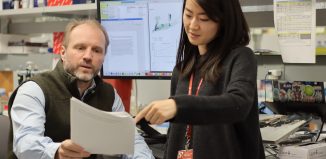Comparing genetic codes of mice, flies and humans
In the 1970s, when he was in graduate school at New York University, Thomas Gingeras said his late mother, Barbara Lammons, described him as a vet for flies. While earning his Ph.D., Gingeras brought home bottles of one of the more common scientific test subject, the fruit fly, and stored them in a bathroom.
Almost four decades later, Gingeras, a professor at Cold Spring Harbor Laboratory, still works with flies, although he doesn’t need to bring any of them to his home on the campus at the laboratory. Instead, he is one of the leaders in a group called Encode, for the encyclopedia of DNA elements.
The Encode project includes scientists from around the world and provides a detailed catalog of genetic elements.
The latest version, called modEncode, for the Model Organism Encyclopedia of DNA Elements, compares genetic elements of humans to those of flies and the roundworm, two of the more actively studied by science.
Using billions of pieces of information including DNA base pairs and messenger RNA, scientists were able to explore the overlap in genetic machinery among members of species with considerably different lives.
“What we see,” Gingeras said, “are patches of things where the sequences that are known to carry out specific functions relate to one another.” These results were recently published in the journal Nature.
He likened the study to an examination of paintings. Looked at from a distance, the way a fly, worm and human might be seen, the end product appears different. “When you look at small areas, you can see” similarities among the paintings.
By finding overlap, scientists can hone in on ways to repair damage and provide additional genetic targets to cure human disease. “This points us in the direction of setting these at the top of the priority list,” said Gingeras. One of the primary paths pharmaceutical companies pursue is that “they look to find a disease state that is closely mimicking what is happening in humans. They look to see if the cause is similar, in their genes and regulatory regions.”
In his lab, Gingeras has five people who do benchwork, producing genetic data. Another five dedicate their time to making sense of that information, plugging bits of data into computers and looking for meaningful overlaps. Gingeras divides his time between analyzing and interpreting the data, writing for grant money and summarizing results in research papers.
Gingeras said the Encode group has been through some battles in the scientific community, especially when they first proposed the idea that the genes that don’t code for a specific element still might have a function for the organism and for the cell.
“The predominant idea when the human genome sequence was deciphered is that only a small fraction of the genome was functional,” about 2 percent, Roderic Guigo Serra, coordinator of the Bioinformatics and Genomics Program at the Center for Genomic Regulation in Barcelona explained in an email. “Gingeras “demonstrated that the fraction of the genome that is transcribed is much larger,” closer to 60 percent or more. Initially, Gingeras’s results were viewed with skepticism; they are now “widely accepted.”
Gingeras admitted that the early criticism bothered him.
“I took it very personally,” he said. “Not too long into this process, it dawned on me that it doesn’t make any difference what anybody thinks. If it’s right, [other scientists] will see it for themselves.”
Serra, who started collaborating with Gingeras more than a decade ago, said his colleague has “amazing energy,” and can call him to discuss their work at almost any hour of the day. This, he said, has been challenging but also motivating for Serra. Gingeras “has the insight to anticipate the questions that will become important before others,” he said.
Gingeras and his wife Hillary Sussman, who is the executive editor of the journal Genome Research at CSHL, have a 12-year-old daughter, Noa Sussman and a 5-year-old, Arie Anna Gingeras.
As for his work, Gingeras said the next steps in the analysis of genomes could include other organisms.
“The intention has been, all along, to provide a blueprint of what you could do on any organism to understand better what the component parts of the organism are,” he said. “This effort is meant to be a model case of what you could do for all organisms. The next step is to do the same thing for other organisms or study systems.”






